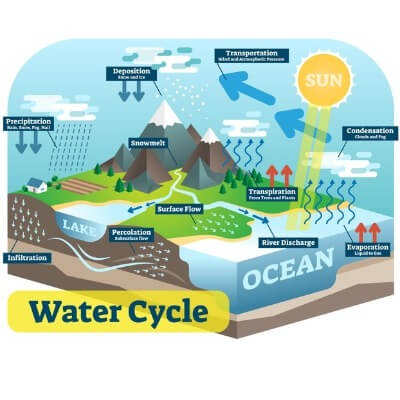
This web page contains water cycle facts for kids and is an excellent resource for anyone of any age looking to learn about the Earth’s water cycle. Our goal is to provide you with accurate, up to date facts about the water cycle. In addition to facts about the water cycle, we provide additional resources to help you with your research on this important cycle.
The water cycle facts below will help you learn about the water cycle, how the water cycle works, what are the parts of the water cycle, why the water cycle is important and other water cycle related facts. We hope these water cycle facts are interesting and help you learn more about this important cycle that supports life on Earth.
If any of the below water cycle facts are inaccurate, please contact us and let us know.
25 Water Cycle Facts for Kids
- The water cycle is the continuous movement of water on the planet Earth.
- The water cycle transfers water from one state to another and from one location to another.
- The water cycle converts water into all three different states; liquid, solid (ice) and gas (vapor).
- The processes of the water cycle are evaporation, condensation, precipitation, infiltration and surface runoff.
- The evaporation process of the water cycle turns liquid water into a vapor (gas).
- The condensation process of the water cycle turns water vapor into a liquid when it touches a surface.
- The precipitation process of the water cycle turns water vapor in the atmosphere into a liquid.
- The infiltration process of the water cycle allows water to enter the surface of the Earth.
- The surface runoff process of the water cycle allows water that can’t enter the Earth’s surface to flow in the direction of least resistance and merge with a lake or river.
- The water cycle ensures that freshwater sources are continuously replenished.
- The water cycle helps drive the climate of our planet through the exchange of energy.
- The sun powers the entire water cycle process on Earth.
- The sun heats water in the ocean and causes it to evaporate.
- The evaporated water forms clouds in the atmosphere.
- Those clouds eventually release the water as precipitation.
- The precipitation released by clouds can be in the form of rain or snow.
- Snow falls in cold climates and on mountains with high elevations.
- The snow from mountains and highly elevated land melts and creates snowmelt runoff.
- The snowmelt runoff creates streams and rivers, it also seeps water into the ground.
- These streams and rivers feed water into lakes and the ocean.
- The water that seeps into the ground is stored in aquifers, or feeds back into the ocean.
- Rain falls in warm climates at all elevations.
- The water produced by rain can feed lakes, ponds, rivers and streams, it also seeps water into the ground.
- As with snowmelt, the water from rain that ends up in rivers will eventually feed back into the ocean.
Pictures of the Water Cycle
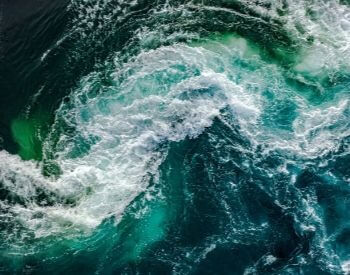
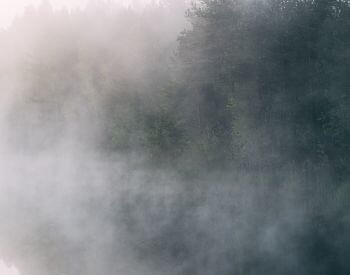
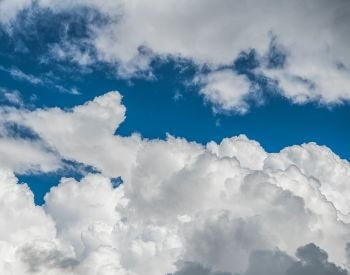
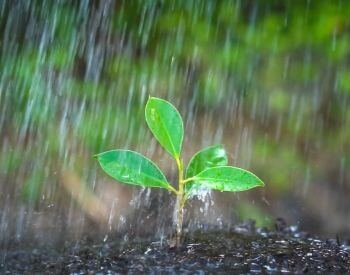
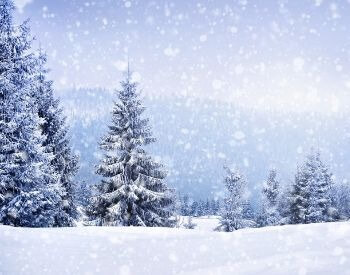
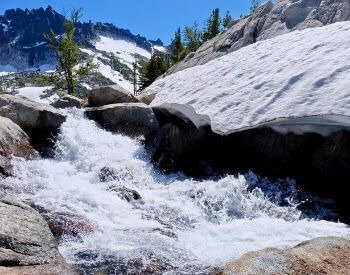
Additional Resources on the Water Cycle
- The Water Cycle – Discover the Earth’s water cycle on NASA’s Precipitation Education website.
- The Fundamentals of the Water Cycle – Learn about the fundamentals of the Earth’s water cycle on the USGS website.
- Meet the Water Cycle – Find more information about the Earth’s water cycle on the NOAA website.
- Water Cycle – Wikipedia – Explore the Earth’s water cycle more in-depth on the Wikipedia website.
